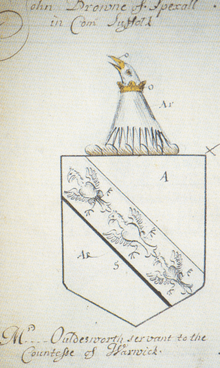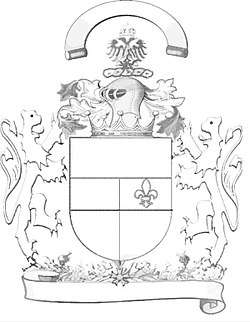Tricking
Tricking is a method for indicating the tinctures (colours) used in a coat of arms by means of text abbreviations written directly on the illustration. Tricking and hatching are the two primary methods employed in the system of heraldry to show colour in black and white illustrations.


Origin
The system of heraldry has always had some methods to designate the tinctures of arms. The earliest such method was blazon, which is describing the arms by words and is as old as heraldry itself. We can find the first blazon in the work of Chrétien de Troyes (c. 1135-c. 1183) titled Lancelot ou le Chevalier de la Charette (c. 1178-c. 1181). The English heraldry system still uses a form of blazon almost unchanged since the reign of Edward I. Traditionally, the images of heraldic manuscripts like the rolls of arms and armorial books are all coloured. However, later on, with the development of book printing as also with the invention of woodcuts and copperplate engravings, there arose the need for designating the colours on uncoloured illustrations as well. As a rule, two main methods were applied to achieve this – tricking or giving designations to the tinctures after the initials of the given colours, and hatching which is ascribing designations to the tinctures by means of lines and dots. While the first method was introduced and developed by the heralds, the second model was developed and adopted by the heraldists. In addition, some other methods were also in use such as giving designations to tinctures by using the numbers from 1 to 7.
In the beginning, tinctures were designated with the given names of the colours as described in the 1576 book by Martin Schrot (d. after 1581), titled Wappenbuch. In his book Baselische Chronik (1580) Cristian Urstis (1544–1588) named the tinctures after the initials of the given colours. Earlier, this method was applied by Virgil Solis (Wappenbüchlein, 1555), and Johann von Francolin (1560).
Almost simultaneously with Urstis, Don Alphonsus [Francisco] Ciacconius (1540–1599), a Rome-based Spanish Dominican scholar, named the tinctures after their Latin initials. Or (gold) was designated with A (aurum), argent (silver) or white, respectively with a (argentum), azure (blue) with c (cearuleus), gules (red) with r (rubeus), and vert (green) by v (viridis). Though the sign for sable (black) (Niger) was not present in his system traditionally it was designated with the black colour itself.
Decline
The letters of tricking were often traced badly since they were not of immediate understanding for the reader always, thus leading to erroneous interpretations. Heralds did not like hatching, and the College of Arms gave preference to tricking even beyond the 17th century, sometimes even on the coloured and hatched images. It was so because the tricking was a simpler way to the drawer than hatching to designate the tinctures.
Otto Titan von Hefner maintained that the first traces of hatching on the woodcuts began during the 15th and 16th centuries. Both tricking as well as hatching was applied by the Benedictine monk, philologist and outstanding historian Vincenzo Borghini (Florence, Oct. 29, 1515 – Aug. 18, 1580, Florence). He drew a difference between the metals and the colours on the woodcuts of his work by leaving the places blank on the arms for all metals; similarly all colours were hatched by the same way, as the colour vert is being used today. Besides this, tinctures were designated in the fields and on the ordinaries and charges by tricking: R–rosso–gules, A–azure–azure, N–nigro–sable, G–gialbo–yellow (or), and B–biancho–white (argent). Notably, the vert was not present on the arms presented by him.
Since the early 17th century, tricking declined. However, it is sometimes still in use, mainly in British heraldry.
References

